 1 2 Jump to
1 2 Jump to
- Goose
- Cogito ergo sum
 Offline
Offline 
- Registered: 1/29/2015
- Posts: 13,427
Making Your Italian-American Cooking More Italian. A Series
#1. Remember, Italian cooking is about balance, not 'abbondanza'.
Maybe when my, and your grandparents came to America they became awestruck by the wealth and abundance of food in the US. I'm not sure. But they did start taking relatively simple Italian food and start super-sizing the portion size and the relative amounts of cheese, sauce and meats.
In my opinion, the single greatest mistake that American cooks make while making Italian dishes is to go crazy with lavish amounts of sauce, or cheese such that one loses the contribution of the noodle to a lasagna, or the crust of a pizza.
Italians are not going to stuff the crust of a pizza with cheese, or, shudder, hotdogs.
Italians are going to dress their pasta with sauce like you would dress a salad, not fill a moat.
Balance
Last edited by Goose (4/28/2018 2:07 pm)
We live in a time in which decent and otherwise sensible people are surrendering too easily to the hectoring of morons or extremists.
- Goose
- Cogito ergo sum
 Offline
Offline 
- Registered: 1/29/2015
- Posts: 13,427
Re: Making Your Italian-American Cooking More Italian. A Series
#2 Dress your pasta properly.
Don't just put you pasta in a bowl and dump sauce over it. With a little effort you can marry the pasta to it's sauce, or condimento.
Have your sauce, red or white, cooking in a wide skillet while you cook your pasta. Cook your pasta until one minute shy of being done. This is easy to accomplish by simply looking at the cooking time listed on the package. No need to throw the pasta against the wall to see if it sticks, or any other silly thing. Just read the directions.
Drain you pasta, and add it to your sauce. Gently stir for a minute and serve.
Simple, right? Too simple to make a difference? Well, you judge.
Disastro!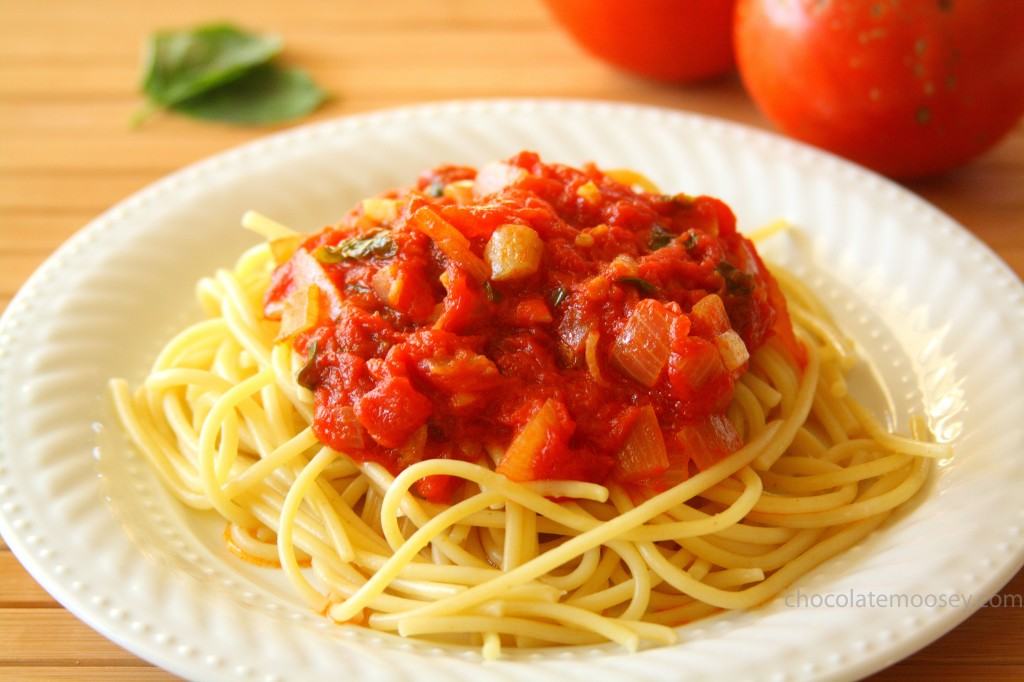
Perfezionare!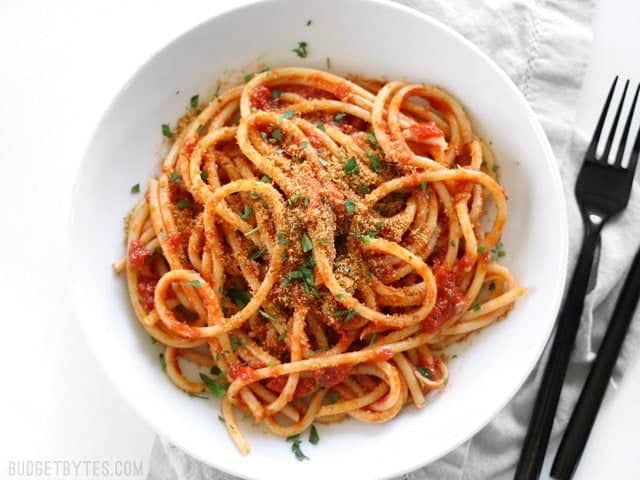
One other thing. Don't discard that pasta water just yet. It's gold. If your sauce is too 'tight' you can add a little pasta water to your pasta sauce mixture. This is especially helpful if you have a white sauce that seems too dry. You might be tempted to add more oil or butter, but this adds calories,,,, and changes the taste. Balance!!
Don't put your pasta in a lake of sauce. Dress it like a salad, and offer more sauce on the side.
Yes
No!
Last edited by Goose (4/30/2018 6:31 am)
We live in a time in which decent and otherwise sensible people are surrendering too easily to the hectoring of morons or extremists.
- •
- Goose
- Cogito ergo sum
 Offline
Offline 
- Registered: 1/29/2015
- Posts: 13,427
Re: Making Your Italian-American Cooking More Italian. A Series
#3 The quality of your ingredients really matters.
Yea, you are thinking "Duh. Mike. Quality matters with all cuisines." Well, you got me there.
But, allow me to explain what I am getting at.
Italian cooking is simple. There are very few dishes that involve complex techniques like cream reductions, or long lists of ingredients.
Let's look at two classic recipes, Spaghetti Carbonara, and a caprese salad.
Spaghetti Carbonara has seven ingredients in it, and two of them are salt and pepper!
A caprese salad has five ingredients (Tomatoes, Mozzarella, Basil, Olive oil, and salt) and you don't even cook them. So, if your mozzarella and olive oil are cheap, or your tomatoes are those supermarket types that are bred to hold up during transcontinental shipping rather than taste good, there is absolutely NOTHING that you can do to make that dish spectacular. It is the sum total of it's ingredients.
Caprese Salad
Now, great olive oil and mozzarella are going to be pricey. But, the best tomatoes come from your local farmers market or hot house. They aren't that expensive when you buy local and in season.
Italian recipes are often a product of the "Cucina povera", the Poor Kitchen. They get high quality ingredients not by spending lots of money, but by focusing on freshness. You have to be flexible and diligent. Use your eyes and your nose, and walk away from a recipe if the ingredients just aren't right.
Here's an example. We have fish about twice a week in my house. On "Fish Day" I used to plan my menu in detail and then go to the fish market to buy exactly what the recipe called for. If the recipe called for salmon, then by golly I was going to buy salmon, whatever the price, even if what the market had looked a little tired.
Today, I go shopping first. I search for the freshest, best looking thing in the case, I talk to the fishmonger about good 'lesser cuts' that are often overlooked. Then, with the best looking fish in my basket, I build a recipe around it.
I also moved beyond the pre-sliced prosciutto or pancetta in the vacuum pack, and instead get it from the butcher. Same thing about Italian Sausage. Find a Farmers market that has a local product, or even makes their own. These products are out there. And finding them, rather than the mass produced stuff will improve your cooking immensely.
It's the Italian way.
Last edited by Goose (4/29/2018 12:54 pm)
We live in a time in which decent and otherwise sensible people are surrendering too easily to the hectoring of morons or extremists.
- •
- Just Fred
- Duke of Cortona
 Offline
Offline 
- Registered: 1/29/2015
- Posts: 3,863
Re: Making Your Italian-American Cooking More Italian. A Series
Perfect! I'm going back to Florence in September and you are making me nostalgic for all of this. Sometimes the people that accompany me ask me, "Can you recommend as good restaurant?" I say, "Swing a dead cat and you'll hit one."
- Goose
- Cogito ergo sum
 Offline
Offline 
- Registered: 1/29/2015
- Posts: 13,427
Re: Making Your Italian-American Cooking More Italian. A Series
#4 Move beyond Marinara Sauce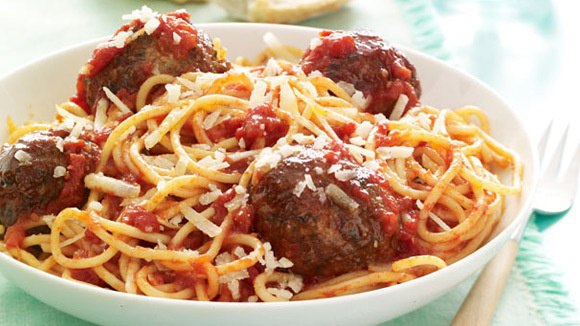
Who doesn't love a Sunday dinner of Spaghetti and meatballs? Only problem is, it's not Italian.
Contrary to popular belief, if you travel to Italy, you won’t likely find a dish called spaghetti and meatballs on the menu. (And, if you do, it was placed there for American tourists). While it’s largely known as an Italian dish, spaghetti and meatballs actually didn’t originate there. Sure, Italy has their own version of meatballs, but they’re different than what you’ve likely had in the past. They’re called polpettes, and are primarily eaten sans spaghetti. They’re also made with any meat, from turkey to fish, instead of primarily ground beef and are made no bigger than golf balls.
The origin of spaghetti and meatballs started with Italian immigrants coming to America in 1880 to 1920. The majority of immigrants were extremely impoverished, and had been spending 75 percent of their income on food in Italy, compared to only 25 percent in the U.S. Meat quickly became a staple, and families were putting meatballs more frequently on the table.
Then came the sauce. For cooks in the United States, “sailor sauce” dominated Italian-American cuisine because canned tomatoes were among the only items available at local grocers. The marinara sauce originates from Naples and comes from the Italian word “marinaro,” meaning sailor.
Spaghetti also became greatly popular in the U.S. because it was one of the only Italian ingredients available. Soon people began eating all three together.
Much of what we consider "Italian" food comes from Naples, and the surrounding southern Italian countryside, because that is where the majority of Italian immigrants to the US came from.
Marinara, Eggplant Parmesan, Pizza, all come from Naples and Campania.
And, it's great.
Forget the printing press. Pizza may be the greatest invention in the history of Man. ![]()
However, Italy is much more than Naples. It's Sicily, in the south with citrus, and Flavors brought by Arab Traders. There is Lazio and Rome with it's artichokes, the Tuscan countryside with it's wild boar, Liguria with it's pesto, Milan with it's veal and rice dishes, the Veneto,,,,,, you could spend a lifetime exploring it.
Getting back to 'spaghetti', or pasta.
Expand your horizons. The Italians have hundreds of shapes of both fresh and dried pasta with perhaps thousands of preparations. Get out there and try making some. Many sauce, or condimento recipes can be prepared in the time it takes to cook your pasta.
Here are two favorites of mine:
Orecchiette ("Little Ears") with Sausage and Broccoli Rabe
This dish is the unofficial, official dish of Puglia. Puglia is the heel of the Boot.
ORECCHIETTE WITH PORK SAUSAGE AND BROCCOLI RABE
1 pound Orecchiette
1/2 cup olive oil
1 pound loose sweet italian sausage
3 cups broccoli rabe (cut into 1-inch pieces)
2 cloves garlic (peeled, grated)
1/2 teaspoon red pepper flake
1 cup Pecorino Romano (grated)
Kosher salt and freshly ground pepper (to taste)
Bring a large pot of salted water to a boil. Drop Broccoli Rabe in for two minutes and remove and drain in a colander. Then wring dry with paper towels.
In same water add pasta and cook until pasta is al dente, roughly 1-2 minutes less than the package directions, reserving 1/2 a cup of pasta water to the side.
While pasta is cooking, heat a large skillet over medium heat. Add the olive oil and sausage to the pan, breaking it up with a potato masher or wooden spoon as it cooks. Cook for 10 minutes or until the sausage is almost fully cooked. Add the broccoli rabe and season with salt and pepper.
Once the broccoli rabe begins to soften, add the garlic and red pepper flake and cook until fragrant. Add in the pasta and the reserved pasta water and stir to combine. Remove from heat and stir in the pecorino and a drizzle of olive oil to taste.
SHEPHERD'A PASTA
This pasta dish, also known as Pasta al Pastore is said to have originated in Calabria by sheep herders.
Calabria is the toe of the boot.
This is another one of those quick and easy pasta dishes that you can put together in the time it takes you to boil the water and cook your pasta. I’ve read many online sources describing this pasta, also called Pasta al Pastore, and it is claimed to have originated from Calabrian sheep herders who needed to make a quick, hearty meal with ingredients they have on hand.
Ingredients:
1/2 Pound Fresh Mild Pork Sausage, Removed From Casings
2 Cloves Garlic, Peeled & Minced
1 Pound Of Pasta, Rigatoni, or rotini
2 Tablespoons Olive Oil
1 Pound Fresh Ricotta Cheese
Salt & Pepper
1/3 Cup Grated Pecorino Romano Cheese
TO SERVE:
Cracked Black Pepper
Additional Grated Pecorino Cheese
directions:
Place a large pot of salted water on to boil for the pasta.
In a heavy skillet, cook the sausage until lightly browned, breaking up the sausage meat with two forks as it cooks.
Add the garlic and cook until fragrant.
Add a couple of tablespoons of pasta water to the skillet and keep warm over low heat.
Cook the pasta until al dente, then drain the pasta, reserving a cup of the pasta water.
Return the pasta to the pot and add the olive oil and sausage over medium heat stirring to mix.
Add the ricotta, and enough of the pasta water to loosen the ricotta so it coats the pasta and remove from the heat.
Season with salt and pepper and stir in the 1/3 cup of grated Pecorino cheese.
Serve the pasta in individual bowls, offering additional cheese and cracked black pepper at the table.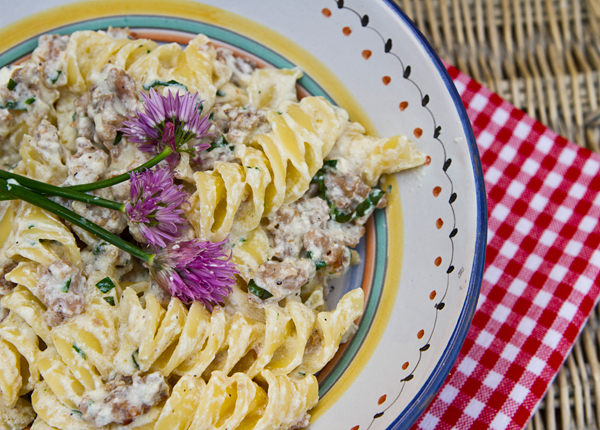
Last edited by Goose (4/30/2018 6:21 am)
We live in a time in which decent and otherwise sensible people are surrendering too easily to the hectoring of morons or extremists.
- •
- Goose
- Cogito ergo sum
 Offline
Offline 
- Registered: 1/29/2015
- Posts: 13,427
Re: Making Your Italian-American Cooking More Italian. A Series
#5 Get to know olive oil.
So much of Italian cooking hinges on using local ingredients. However, if you live in the northeast US, you are going to have to get olive oil from far away. Shop wisely.
Olives are harvested in Italy in November and December. The olives are pressed to produce oil. This first pressing produces Extra Virgin Olive Oil, which is the highest quality.
After that, the olives are heated, and treated with chemicals before being pressed again. This produces a lower quality product labeled simply Olive oil.
Always use extra virgin olive oil. You can use a supermarket brand for all of your frying needs. But, look for a higher quality oil for salads, or drizzling on asparagus or a caprese. For this high quality oil, look for oils from a single region or estate in Italy.
Be careful. It seems that every olive oil has an Italian sounding brand name. Some careful label reading, however, may reveal that the olives are imported from Tunisia or Spain, and pressed in Italy. Now, there is nothing wrong with Spanish olive oil. But, do you really think that they are shipping their best olives in the cargo hold of some rust bucket to Italy?
Read the label. It should say, Made from olives grown and pressed in Italy.
You may see Light Olive oil in the store. Don't buy it. Contrary to what you might think the 'Light" does not mean that it's better for you. ALL olive oil is 100% fat. Light olive oil simply has a 'light' or bland flavor designed not to offend. You lose that great fruitiness of real oil. Light olive oil is fit for one purpose: to dress salads in hell.
Aging olive oil? In a word, NO. You might be tempted, after spending a king's ransom on a bottle to save it for Christmas or special occasions, like you would a fine wine. Olive oil is not like wine. It does not improve with age. It is best the day it is bottled. Olives are harvested once a year. Use your bottle within the year.
A Favorite for cooking
A great, highest quality oil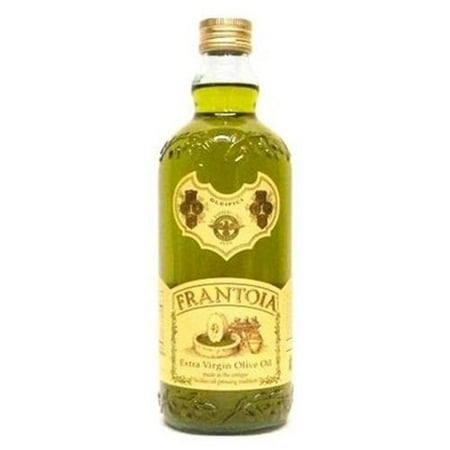
Last edited by Goose (5/14/2018 12:18 pm)
We live in a time in which decent and otherwise sensible people are surrendering too easily to the hectoring of morons or extremists.
- •
- Goose
- Cogito ergo sum
 Offline
Offline 
- Registered: 1/29/2015
- Posts: 13,427
Re: Making Your Italian-American Cooking More Italian. A Series
#6 Lose the Green Can
Get rid of this fixture from American pantries and get cheesy!
How can it be "100% Parmesan" when it contains cellulose, potassium sorbate and cheese culture?
Hey, life is too short to eat wood pulp. "Real" Parmesan contains, only, Milk, salt, and rennet. That's it.
What the heck is parmesan cheese anyway?
Well, Parmigiano-Reggiano is an Italian hard, granular cheese. The name "Parmesan" is often used generically for various simulations of this cheese, although this is prohibited in trading in the European Economic Area under European law.
It is named after the producing areas, which comprise the provinces of Parma, Reggio Emilia, Bologna (only the area to the west of the river Reno), Modena (all in Emilia-Romagna), and Mantua (in Lombardy, but only the area to the south of the river Po), Italy. Under Italian law, only cheese produced in these provinces may be labelled "Parmigiano-Reggiano".
Why spend money on parmigiano? Because it is the undisputed king of cheeses. Great Parm has a nutty quality to it. It improves everything you put it on. And, you can find it in better supermarkets all over the US.
The cheese is made in these huge rounds and aged to dry.
Then it is cut into smaller pieces for sale.
Buy wedges of the cheese and grate it when you get home. Buying previously grated cheese leaves you open to being cheated. You don't know with absolute certainty what it is if you do not see the cheese in it's raw form.
And yes, 'Food Fraud' is common. It's a several billion dollar a year industry, in fact.
Save the outer edge, or rind of your parmigiano. You can then toss it into a big kettle of red sauce, or even soup to melt away and add richness to your dishes.
In the south of Italy we often use Percorino Romano as our grated cheese on pasta. Pecorino is a sheep's milk cheese. (Parmigiano is from cows milk.) Pecorino tends to be a bit cheaper, which is a nice thing.
Pecorino is much saltier, so keep that in mind when using.
Well, that's two.
Italy makes about 450 varieties of cheeses.
More later. ![]()
Last edited by Goose (5/28/2018 6:41 am)
We live in a time in which decent and otherwise sensible people are surrendering too easily to the hectoring of morons or extremists.
- •
- Goose
- Cogito ergo sum
 Offline
Offline 
- Registered: 1/29/2015
- Posts: 13,427
Re: Making Your Italian-American Cooking More Italian. A Series
#7
Stop buying bottled salad dressing.
I am the kind of person who buys a bottle of salad dressing, uses it once and then promptly forgets about it in a jumble of other condiments until well after the expiration date. I suspect I’m not alone.
Even when I have a bottle of dressing socked away, I am much more tempted to just whip up a quick vinaigrette myself. That way, I never have to worry about being stuck with too much (although you can make more if you would like extra), and I can make it exactly the way I want. Plus, it’s a great way to use up the extras of all those other ingredients languishing in the fridge.
Oil
This is the backbone of most dressings, so put some thought into it, and buy a good one. The everyday choice is extra-virgin olive oil; choose one you like the taste of and are willing to cook with, whether it’s mild, fruity or more assertive.
Acids
If you’re making a vinaigrette, of course your most obvious acid is going to be vinegar. You have a lot to choose from (just stay away from regular distilled white, which is best left for pickling and cleaning). Balsamic (the dark has a more robust flavor than white) is an all-around great choice. If you have that and a nice olive oil, but not much time, you’re done, if you like.
But try branching out sometimes. Cider vinegar is fruity, and sherry vinegar is nutty. Red wine vinegar is assertive (pair it with sturdy bitter greens or vegetables), while white wine vinegar is less assertive (think more delicate greens).
Emulsifiers
Emulsifiers help bring a dressing together and keep it from separating. My favorite all-purpose option is Dijon mustard, which is milder than spicy brown or classic yellow but still packs a zesty punch that pairs well with the vinegar and cuts through oil. Honey is another possibility, one to consider if your dressing or salad ingredients are already very acidic. Sometimes I do a bit of both mustard and honey. You can also use egg yolks, or their derivative, mayonnaise. Yogurt (full-fat regular, not Greek) is good, too.
Wild card/other flavors
You can add almost anything you want to your vinaigrette. How wild do you want to go?.
If you’re after an aromatic or bright pop of flavor, use fresh herbs. Finely chop them, muddle them in the bottom of your jar or blend them in, depending on how you’re making the dressing. Garlic and shallots are good. Dried herbs and other pantry spices are at your disposal as well.
If you like smoky flavors, reach for chipotles en adobo, smoked sea salt, smoked paprika or even charred fruits or vegetables.
Here’s how to make and use a vinaigrette, now that you have an idea of what goes into it.
Start with the classic ratio. The traditional ratio of oil to vinegar is 3 to 1 (i.e. 3 tablespoons oil per 1 tablespoon of vinegar). That’s a good place to start before you start tweaking, which comes into play once you start to . . .
Think about balance — and taste it. You want balance not only with what’s in your vinaigrette but also with the components of the salad. Is your salad big on bitter greens and tomatoes? Maybe emphasize oil and sweet flavors in your vinaigrette, or make it creamier. If you have a lot of neutral salad elements — cucumber, summer squash, iceberg lettuce — try for something sharper. Taste along the way, adding salt and pepper as needed. Dip one of your salad components in the dressing to see if the combination works.
Mix it up. For simplicity and ease at home, if you’re not making a large quantity, I think a jar is great. Put all the ingredients in a glass jar with a lid and shake away. You may be surprised how quickly and evenly it comes together. If you really need to blend ingredients together into a uniform dressing — if you’re pureeing herbs or produce or using thicker ingredients — go for your blender or food processor. Especially if you’re not too concerned about a perfect emulsion, a good old whisk and bowl can work, too.
Dress the salad at the right time. Homemade dressings should last at least a few days in the refrigerator. (Shake them again if they separate.) If you’re using your vinaigrette on something sturdy or hearty, a grain salad or grilled/roasted vegetables perhaps, you can apply the dressing in advance. This will help the flavors meld, too.
More delicate dishes, such as a traditional green salad, should be dressed right before serving to avoid wilting. Give a good toss.
And, don't drown the salad. If there is a large puddle at the bottom of your bowl after the salad has been eaten, you can probably cut back next time.
Use vinaigrettes for more than salads. Try different applications for your vinaigrette, as a dip, marinade or sandwich condiment. Grill pepper slices, zucchini, onion, asparagus etc, and serve with dressing at room temperature.
You could even drizzle it over a cold soup or gazpacho. There’s kind of a fine line between all of those things, meaning they’re often interchangeable.
Croutons?
Sure. But make your own sometime. Some day old Italian bread from your pantry is perfect. But heck, some old Thomas's english muffins would make better croutons than you can find in the store.Cut your day old bread into small cubes, toss with olive oil and brown in a hot skillet. Remove to a paper towel and salt while hot. Let cool completely before placing in a tupperware contaner. They will keep for a couple of days.
Last edited by Goose (6/30/2018 1:57 pm)
We live in a time in which decent and otherwise sensible people are surrendering too easily to the hectoring of morons or extremists.
- •
- Goose
- Cogito ergo sum
 Offline
Offline 
- Registered: 1/29/2015
- Posts: 13,427
Re: Making Your Italian-American Cooking More Italian. A Series
Embrace the Pig.
Italians like a good pork roast as much as do Americans. But, the true genius of Italians is in their curing of the pig.
Guide to Cured Italian Meats: Salami, Salame, or Salumi
Coppa (and/or Capicola / Capocollo)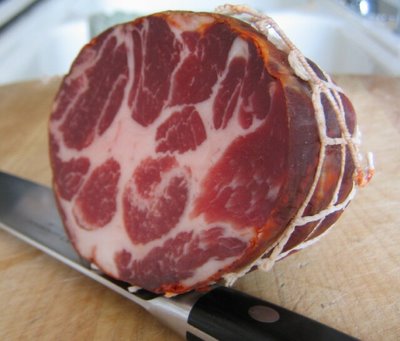
My all time favorite cured meat and apparently Tony Soprano enjoyed it as well (though his pronunciation of the delicacy wasn’t exactly grammatically correct). Capo means head or neck in Italian and the capicola is made from the neck or shoulder of a pig. Capicola has a tender texture and usually smoked and prepared with a variety of spices, herbs, and sometimes wine. I enjoy capicola in a sandwich made from fresh baguette. I usually don’t include any condiment or cheese as I don’t want to mess with the flavor of the meat.
Cacciatore (salami or dried sausage made from ground pork)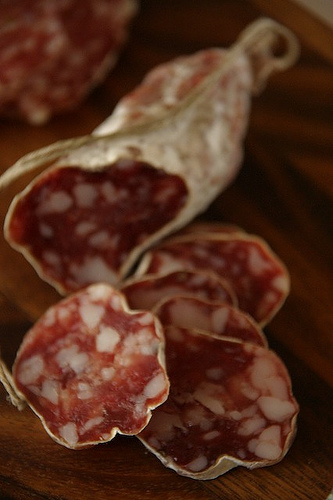
Literally means hunter and the folklore states that hunters used to carry this small salami in their pack and eat several pieces for sustenance during the hunt. Cacciatore is usually 6-7 inches in length and cured with the usual spices, wine, and herbs. Cacciatore tends to be a bit tougher than Capicola or Prosciutto. I love cacciatore with sharp Provolone and good bread. You could use the meat for a sandwich but the small pieces aren’t ideal.
Soppressata (salami or dried sausage made from ground pork)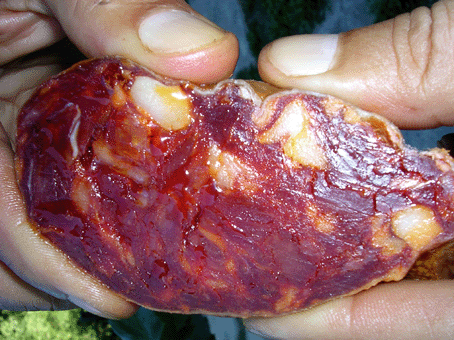
Like cacciatore, Soppressota is made from pressed pork belly, tongue, stomach and other parts of the pig. Again, spices and herbs vary by region and preference. Soppressota can be spicy and is an excellent meat for sandwiches. If you want to try and make your own see Michael Rhulman’s recipe on his exceptional food blog. Soppressata is less chewy and compacted than cacciatore and has the consistency of sausage. Generally speaking it’s important to note that most salumi are either categorized into products made from ground pig parts or from whole sections of the pig (for example, sopresseta versus prosciutto).
Guanciale
Guanciale is cured unsmoked Italian pig jowls or cheeks. The word Guanciale comes from the Italian word guancia, meaning "cheek". A specialty from the Umbria and Lazio regions of Central Italy, Guanciale is a traditional ingredient in such dishes as pasta all'amatriciana and spaghetti alla carbonara.
Guanciale is Italian pork bacon that is prepared by rubbing the meat with salt and curing it for one month. Guanciale is then seasoned with pepper and spices such as thyme, fennel, coriander and rosemary. After the Guanciale is air-dried, it is ready for consumption.
Prosciutto
Prosciutto (made from the back leg of the pig) or dry cured ham comes in two different styles: prosciutto crudo (uncooked) or prosciutto cotto (cooked). Prosciutto di Parma or San Daniele (from Friuli and Emilia) are examples of prosciutto crudo.
Prosciutto is most often sliced thin and served as an appetizer, either alone or wrapped around another food item. Prosciutto is often paired with sweet foods like melon or dates but is also served wrapped around fresh or lightly cooked vegetables, like asparagus. Thinly sliced prosciutto is often served as a part of a meat board or tapas spread. With the popularization of gourmet pizzas, prosciutto has become a trendy topping for pizzas.
The rind or unsliceable ends of prosciutto can be diced and cooked into soups and stews for added flavor. These ends are usually sold for a much lower price than the thinly sliced flesh.
Prosciutto is extremely delicate and can be quite sticky, so slicing must be done with either an extremely sharp knife or a professional grade meat slicer. Presliced prosciutto is often packaged with deli paper between the slices to facilitate handling the slices without tearing.
Protected Designation Origin
The European Union created the Protected Designation of Origin policy (PDO) to protect the name of regions and their agricultural products. Under this policy, only products produced in said regions are allowed to carry that name. The two most popular varieties of prosciutto protected by the PDO are Prosciutto di Parma and Prosciutto di San Daniele.
Prosciutto di Parma is made in Parma Italy, the same region well known for Parmesan cheese. The pigs raised in this region are often fed whey left over from the cheese-making process, which gives the meat a slightly nutty flavor.
It is incredibly expensive and worth every cent.
Prosciutto di San Daniele comes from San Daniele del Friuli in Italy and is known for it’s slightly sweeter flavor and darker color.
Salt Pork
Most salumi affeciondads have a love hate relationship with salt pork; I happen to love this fatty, bacon like, salumi but it tends to be very salty. Moreover, I don’t particularly like cooking with salt pork, thought most folks use it as a fat for sautéing. I enjoy salt pork cut very thin with chunks of parmiggiano reggiano and a glass of homemade wine (I think the juxtaposition of the complex and creamy parmiggiano goes will with the simple, salty, and earthy flavors of homemade wine and salt pork). Salt pork is made from the pig’s belly and is not smoked.
Spalla
From the Academia Barilla web site, “Spalla is made from a large pork shoulder (preferably 46 to 48 lbs), including the coppa (a specific cut of pork neck and shoulder). After having remove the excess meat and rolled up the spalla, it is left to cure in a mixture of salt, pepper, cinnamon, garlic and nutmeg. It is places in a cold room, salted a second time and left for a couple of weeks. Then it is tied up, placed in a bladder casing and bound again from the bottom up. It is left in a cold environment for one to two months before consumption. It can be eaten raw, if well aged, or cooked, its more common form. The preparation, which follows very specific rules passed down through the centuries, calls for cooking the spalla in hot but not boiling water (160-175° F), seasoned with wine and bay leaves.”
Lardo
Lardo is produced from back fat and usually cured with rosemary. The most prized lardo is produced in the city of Carrara in northern Italy and usually consumed with a glass of white wine for a wonderful anitpasto.
Pancetta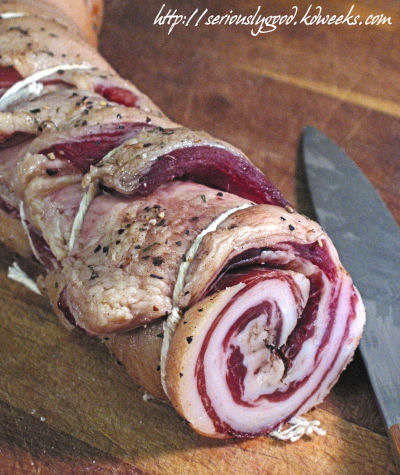
As you probably guessed, Pancetta is another salt cured and spiced salumi made from the belly of the pig. Most folks know pancetta and fry it to use in varied dishes. Pancetta when done is small batches is usually produced in a flat manner with the fat located on one side (unlike the rolled kind you will find in most shops in US). I’ve had both varities and it’s not one of my favorites. See Rhulman’s recipe if you want to try and make pancetta at home:
Speck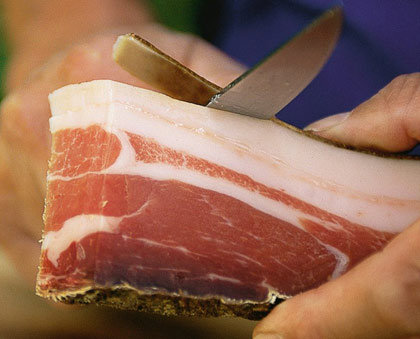
Speck is a type of Prosciutto made with the hind leg of a pig, however the bone is usually removed with this kind of salumi. Speck is usually cut thin and served with bread. The flavor is robust and the texture a bit chewy. Speck is also a smoked product. I’m not a big consumer of this cured meat, but it is tasty.
Culatello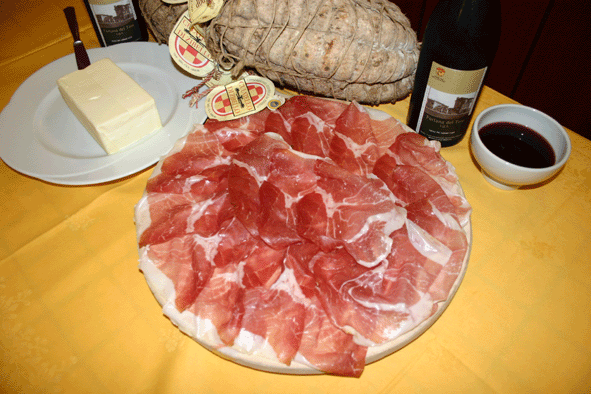
Culatello is a special type of Prosciutto made via larger pigs. Culatello is a prized cured meat and extremely flavorful. Here’s a nice write up on Culatello as I don’t have too much experience with the product (it’s a bit expensive).
Also, see La Cucina Italiana’s salumi FAQ as well as their Oct, 2009 article on artisinal salumi makers in the US. There’s an almost infinite variation of salumi produced in Italy and to catalog each and every variety would be on the scale of trying to catalog every variation of pasta shape.
Last edited by Goose (7/29/2018 7:13 am)
We live in a time in which decent and otherwise sensible people are surrendering too easily to the hectoring of morons or extremists.
- •
- Goose
- Cogito ergo sum
 Offline
Offline 
- Registered: 1/29/2015
- Posts: 13,427
Re: Making Your Italian-American Cooking More Italian. A Series
Make a Fresh Tomato Sauce
Most of the time when you have "Red" sauce in an Italian restaurant in the States it will be made with canned tomatoes. And that is fine, especially if they use the legendary San Marzano tomato.
But, as well enter the second week of August, peak tomato season as arrived in the Northeast. So, it is the perfect time to take a local, fresh ingredient and change it very little from it's natural state. So, go out in your garden, a friend's garden, or your local farmer's market and get some very ripe tomatoes. Try to avoid supermarket tomatoes. Why? Because they are bland. Supermarket tomatoes are bred to grow to a uniform size and shape, which makes them appealing to the eye while in the case. They are also bred to hold up well for shipping long distances. Unfortunately you can't have everything. They taste a lot like the packing material.
Get ugly, super ripe and super good tomatoes. And don't cook them to death.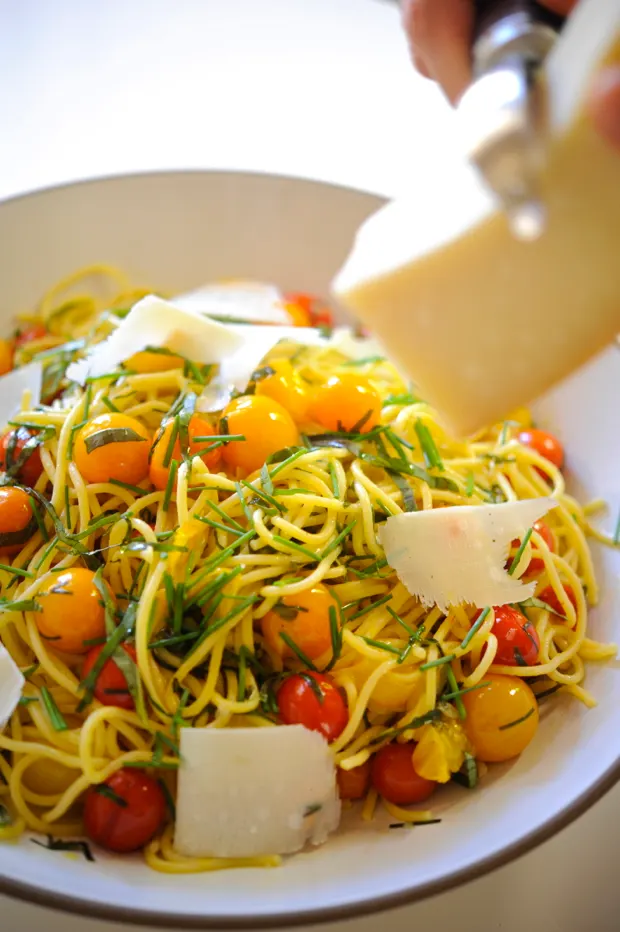
INGREDIENTS
Kosher salt
1/4 cup extra-virgin olive oil
4 garlic cloves, thinly sliced
1 pint Sweet 100 tomatoes or other tiny tomatoes
1/2 bunch of garlic chives, cut into 1-inch lengths
12 fresh lemon basil leaves, finely shredded
Freshly ground black pepper, to taste
1 pound spaghetti
PREPARATION
1 Bring 6 quarts of water to a boil and add 2 tablespoons of salt.
2 In a 12- to 14-inch sauté pan, heat the olive oil over high heat until almost smoking. Lower the heat to medium-high and add the garlic cloves. Cook for 2 minutes, or until softened and slightly browned. Add the tomatoes, chives, and basil and cook over high heat until the tomatoes are just beginning to burst. Season with salt and pepper.
3 Meanwhile, cook the spaghetti in the boiling water according to package directions until it is tender yet al dente. Drain the pasta and add it to the pan with the tomatoes. Toss over high heat for 1 minute, then divide evenly among four warmed pasta bowls and serve immediately.
We live in a time in which decent and otherwise sensible people are surrendering too easily to the hectoring of morons or extremists.
- •
 1 2 Jump to
1 2 Jump to